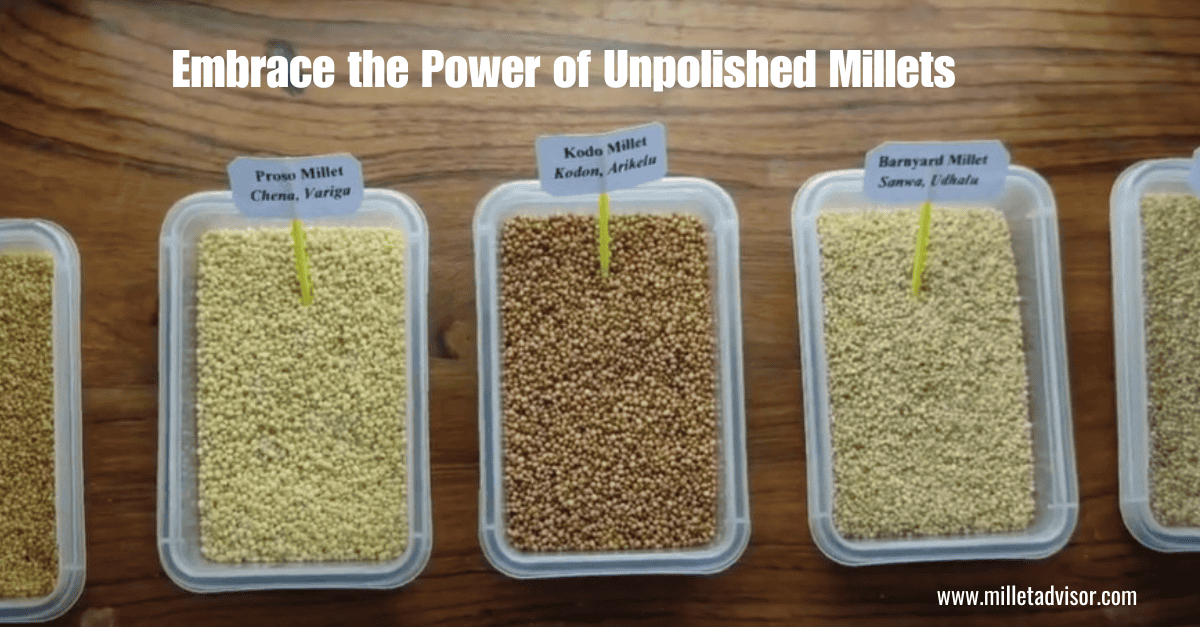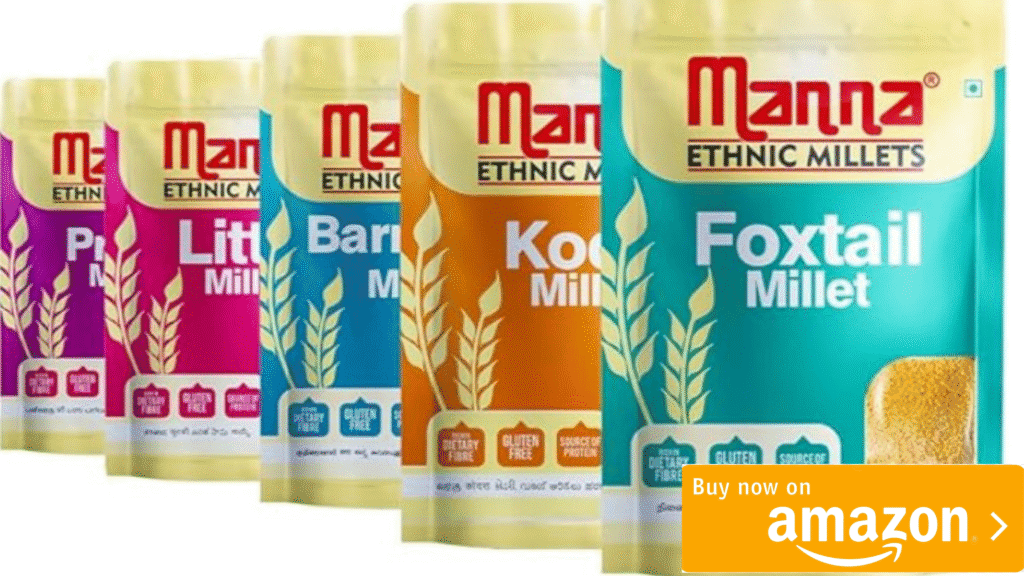Table of Contents
Unpolished Millets:
In a time when highly refined and processed foods dominate our diets, returning to ancient grains like millets is more than a health trend—it’s a movement toward real, whole, and nourishing food. Among the many types of millets available today, it is the unpolished millets that hold the key to unlocking their full nutritional potential.
What Are Unpolished Millets?
Millets are a group of small-seeded grains known for their resilience, versatility, and impressive nutritional content. Commonly grown in Asia and Africa, millets include major types like Pearl Millet (bajra), Sorghum(Jowar), and Finger Millet (ragi), as well as a group referred to as minor millets, which include: Little Millet, Barnyard Millet, Foxtail Millet, Kodo Millet, Browntop Millet, and Proso Millet.
These minor millets, though small in size, are nutritional powerhouses. However, for them to be suitable for human consumption, they undergo primary processing, a necessary step that involves removing the outer, inedible husk from the grain. This husk is not digestible and must be removed using specialized processing equipment.
Understanding Millet Processing: Why Unpolished Millets Are Better
After husk removal, some processing facilities take an additional step and utilize machines like millet polishers. These machines are designed to remove the bran layer—the part of the grain rich in dietary fiber, protein, essential minerals, and phytochemicals. While this polishing improves the grain’s appearance and may slightly extend shelf life, it comes at a significant nutritional cost.
Why This Matters:
- Bran and germ layers contain up to 70% of the grain’s nutrients.
- Polishing significantly reduces the content of protein, fiber, iron, calcium, and B-vitamins.
- The polished grain may look more appealing, but it offers reduced health benefits.
Hence, whenever you are buying millets—whether from local markets, organic stores, or online platforms—it is critical to choose unpolished millets. They retain the bran layer and, as a result, preserve the nutritional integrity of the grain.
Case in Point: Barnyard Millet – Polished vs. Unpolished Millets
To clearly illustrate the difference, let’s take Barnyard millet as an example. Below is a quantitative analysis comparing polished and unpolished Barnyard millet per 100 grams:
| Nutrients | Polished Barnyard Millet | Unpolished Barnyard Millet |
| Carbohydrates (g) | 65.79 | 68.8 |
| Protein (g) | 6.8 | 10.4 |
| Dietary Fiber (g) | 8.5 | 14.2 |
| Crude Fiber (g) | 4.5 | 11.2 |
| Calcium (mg) | 24.8 | 35 |
| Iron (mg) | 6.2 | 7.1 |
| Thiamine (mg) | 0.37 | 0.45 |
| Niacin (mg) | 4.05 | 4.08 |
| Biotin ( (μg) | 20 | 22 |
| Folate (μg) | 69 | 78 |
Key Takeaways:
- Protein jumps by over 50% in unpolished grains.
- Fiber almost doubles, improving digestion and weight management.
- Calcium and Iron are significantly higher, making it ideal for promoting bone health and preventing anemia.
- The overall antioxidant potential is higher due to the presence of intact phenolic compounds.
Why Choose Unpolished Over Polished Millets?
Refining might make millets look attractive and cook faster, but it strips away what makes them healthy. Here’s a breakdown:
| Nutrients | Polished Millets | Unpolished Millets |
| Fiber | Low | High |
| Minerals (Iron, Magnesium, Zinc) | Lost during Polishing | Intact |
| Protein Quality | Reduced | Preserved |
| Glycemic Index | Higher (Spikes Blood Sugar) | Lower |
Related Post: 11 Amazing Health Benefits of Millet
Nutritional Goldmine Inside Unpolished Millets:
Every spoonful of unpolished millet is packed with nutrients your body craves. Here’s what you get:
1. High Fiber Content: The intact bran in unpolished millets makes them fiber-rich, improving digestion, preventing constipation, and keeping your gut microbiome healthy. Fiber also slows down glucose absorption, making it ideal for individuals with diabetes.
2. Rich in Essential Minerals: Unpolished millets are naturally abundant in iron (for better oxygen transport), calcium (for strong bones), magnesium (heart and muscle health), and zinc (immunity and skin health).
3. Plant-Based Protein: With 7–12% protein, millets are an excellent source for vegetarians and vegans. Pair them with lentils or legumes, and you’ve got a complete protein meal.
4. Low Glycemic Index: Unlike refined grains, unpolished millets release energy slowly. This prevents sugar spikes and crashes, making them a great choice for managing diabetes and maintaining steady energy levels.
5. Naturally Gluten-Free: For those with gluten intolerance or celiac disease, unpolished millets are a safe, nutritious alternative to wheat.
How to Switch from Polished to Unpolished Millets:
If you’ve been using polished millets, transitioning to unpolished varieties is one of the best health decisions you can make. Unpolished millets retain their natural bran, giving them a slightly different texture, color, and shape compared to polished grains. They are usually a bit darker, slightly rough in texture, and more wholesome in appearance—this is where all the nutrients reside. For your reference, here is my video:
Many reputed brands are selling unpolished millets, and you can also source them from local farmers’ markets. Local purchases are often more affordable and authentic. To get started:
1. Start Small
Begin with a small quantity to get familiar with the texture and taste. Replace just one meal a day—swap your usual rice or wheat-based dish with millet porridge, millet dosa, or millet khichdi.
2. Use in Familiar Recipes
Introduce millets through dishes you already enjoy—idlis, upma, rotis, pulao, or even baked goods like muffins and cookies. This makes the transition seamless for you and your family.
3. Soak and Cook Properly
Unpolished millets take slightly longer to cook due to their intact bran. Soak them for at least 6-8 hours before cooking. This not only reduces cooking time but also improves nutrient absorption.
4. Buy from Trusted Sources
Opt for unpolished millets from reliable brands or local markets. Local sources are often fresher, more authentic, and cost-effective.
Final Word: The Time to Switch Is Now
Unpolished millets are not a fad—they’re a return to real food. In their whole form, they’re everything modern diets lack: fiber-rich, nutrient-dense, and naturally satisfying.
Making this small dietary change can have a huge impact on your health, energy, and long-term wellness. Plus, every time you choose millets over refined grains, you’re also making a sustainable choice for the planet.
Author: Tapas Chandra Roy, A Certified Farm Advisor on Millets, ‘Promoting Millets from Farm to Plate’, and an Author of the book -” Millet Business Ideas-Empowering Millet Startups”. In a mission to take the forgotten grains- Millets to Millions. To remain updated on my blogs on Millets, please subscribe to my newsletter, and for any queries, please feel free to write to tapas@milletadvisor.com


